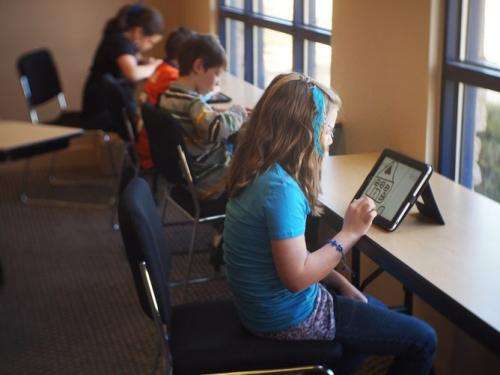Let's chalk up some rules before iPads enter every classroom

Adults and youngsters are willing to queue overnight to get their hands on the latest product release from Apple and children appear to be drawn to iPads because of the immediate feedback they get when they use them.
But as excited as many of us are about how these devices can be used in the classroom, they're still a long way from revolutionising public education.
Tablets certainly have some distinct advantages: they are portable (unlike whiteboards), light-weight (unlike netbooks and laptops), compact and touch-screen (unlike desktop computers) and they offer, so far, the widest range of apps designed for educational purposes.
This software and hardware combo makes them attractive but what really makes teachers excited is the potential to make each lesson tailored towards each individual child's needs. Such personalised learning has been heralded as one of the 21st century's great learning innovations.
However, in all this enthusiasm, we should not gloss over the day-to-day reality. Even in affluent Western countries, iPads are still outside of the budgets of most schools.
In schools where they are used, iPads are a great motivational tool but also harm concentration, as one study of 6,000 pupils in Canada found. Even the students themselves – more than 99% of them – reported they found the tablet a distraction. As for teachers, just one out of the 302 surveyed didn't mention distraction as a "major challenge".
Other schools have found iPads are incompatible with their existing technologies and that security issues have negatively affected their use.
Despite the novel features of iPads, we seem to have forgotten some lessons learnt with previous technologies. Research by Nesta in 2012 found relatively little evidence that technology in schools actually works, considering the money invested. Therefore, to get the best out of iPads we need to think seriously about exactly how they are used as learning tools, and train teachers in the best techniques.
Security lockers and internet firewalls alone won't be good enough to minimise distractions and motivate kids to use their new toys for learning. This is the new technological "playground", and it needs some ground rules. The more we can involve children in making these rules, the easier it will be to uphold them.
Technology and the science of education work together so if we want to see a change, we need to continue develop both. That means not just adding attractive tools like iPads but also devising well-informed guidance for their effective use and integration with the curricular objectives.
Playground rules
We already know a few things that will be needed to make the rules on iPads work well. Some carefully designed studies which look at the intersection of specific technology features with pedagogical principles would be a good start. So that we can reliably say what works, we also need randomised controlled trials and design-based research to allow us to separate assumptions from evidence.
We need more examples of schools where tech solutions have worked. Some steps in this direction have been undertaken, with companies like Airwatch enabling teachers to tailor and customise their lessons using an innovative suite of teacher tools.
And although it has been said before, it bears repeating: we all need to work together. More and more government-funded schemes are trying to encourage collaboration between developers and researchers but these efforts need to be extended to include input from designers, researchers, teachers and parents. All these people are bound by a shared commitment to children and they need to be formally supported to work towards the same goal.
Finally, we need more innovative projects where children are involved in the coding process of the programs they use and where teachers co-design the apps they deploy in classrooms. In other words, we need active participation of all involved, especially children. Because ultimately such joint action will speak louder than words.
We are unlikely to see a revolution, but we can sow some seeds for change if we foster creative thinking and cooperation between all those who care about children and their education.
Source: The Conversation
This story is published courtesy of The Conversation (under Creative Commons-Attribution/No derivatives).
![]()


















